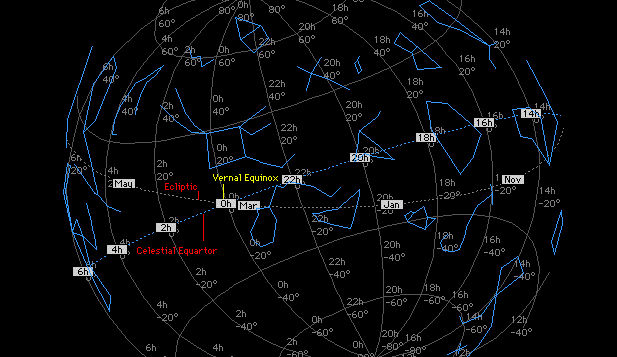

Now, the sun, the moon and the planets' track across the sky on a daily (nightly) basis is due to the earth's rotation. In fact, the entire pattern of stars in the sky moves from east to west as the earth rotates on its axis. But if this was the only motion involved, we would see the sun, the moon and the planets always remain fixed against the background of the stars. In other words, they would always be associated with the same groupings of stars. This is, however, not the case. The moon and the planets move in their own orbits and so, their positions against the fixed background of stars changes. Moreover, as the earth goes around the sun, the night sky's stellar backdrop changes. The combined effect is the appearance that the sun moves from one grouping of stars to another during the course of the year. The moon and the planets also move from one grouping to to another but on a different timescale.
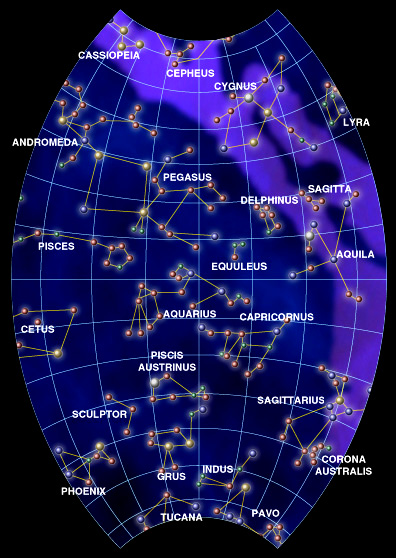 To get a feel for the dynamic nature of the sky, explore AJ's Cosmic Thing. The Cosmic
Thing is a robust, full-featured sky plotter applet, capable of rendering
moving, interactive full-sky plots of brighter sky objects, as seen from any
point on earth. Aimed primarily at the casual observer, the Cosmic Thing
boasts a rich set of features that help make understanding celestial motions
simple, and that help make the sky a familiar, comprehensible thing. Above
all, the applet is designed to show the sky as the dynamic, changing thing it
is. The plots actually move, illustrating the changes over minutes, hours,
days, weeks or months -- demonstrating such subtle phenomena as transits,
retrograde motions of the planets, eclipses, and seasonal changes in visible
groupings of stars.
To get a feel for the dynamic nature of the sky, explore AJ's Cosmic Thing. The Cosmic
Thing is a robust, full-featured sky plotter applet, capable of rendering
moving, interactive full-sky plots of brighter sky objects, as seen from any
point on earth. Aimed primarily at the casual observer, the Cosmic Thing
boasts a rich set of features that help make understanding celestial motions
simple, and that help make the sky a familiar, comprehensible thing. Above
all, the applet is designed to show the sky as the dynamic, changing thing it
is. The plots actually move, illustrating the changes over minutes, hours,
days, weeks or months -- demonstrating such subtle phenomena as transits,
retrograde motions of the planets, eclipses, and seasonal changes in visible
groupings of stars.
In ancient times, people saw patterns in the sky traced out by a nearby group
of bright stars. These groupings or more precisely, the patterns, are known
as constellations. The following two links have further information about
constellations:
![]() The Constellations
The Constellations
![]() Constellations
Constellations
In the northern hemisphere, the star groupings in the direction of the north pole never rise or set. These are known as circumpolar constellations. Other constellations are known as seasonal because whether they rise during the course of the night and the time of the rising will vary over the course of the year.
There is a special set of constellations that lie along an imaginary band
18 degrees wide and centered on the ecliptic.
These constellations are called the 12 constellations of the zodiac.
The sun passes through the
entire set of 12 constellations in a year and on a particular date is, to a
good approximation, in the same location from year to year.
At one time, the zodiac constellations were thought to have great mystical
significance but this belief (astrology) has been shown to be bunk.
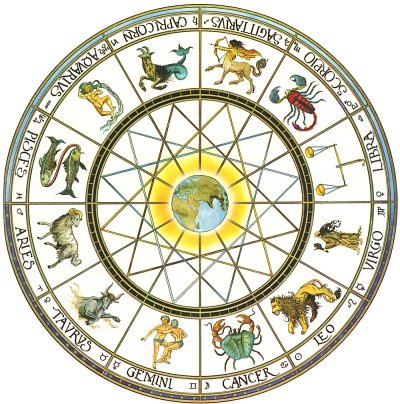
And given, for example, that the sun's position in a specific constellation always appeared to coincide with, say, the end of winter or the coming of the rains, and that survival of human societies depended crucially on favourable climatic conditions and tides, it is not difficult to see how the heavenly bodies would have been perceived to have influences over the destinies of human beings.
The current names of the constellations of the zodiac are Babylonian but their origins are thought to have pre-dated the Babylonian civilization. Alexander Gurshtein, a historian of science, has written an interesting article on the origins of the zodiacal constellations. The full-length article was published in
Very briefly, Gurshtein proposes that a clue to their constellations
may be found by considering the positions of the constellations as they
would have appeared thousands of years ago. In doing so, he finds that
the different star patterns marked out the equinoxes and solstices in
different epochs and that the names attached to the star patterns reveal
the prevalent cultural influences of the time.
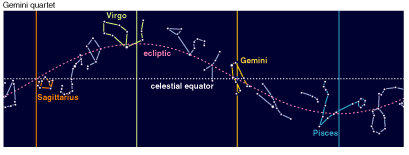
For example, it is believed that the first zodiacal constellations were named in 5600 BC when the four constellations corresponding to the Spring Equinox (Gemini), Summer Solstice (Virgo), Fall Equinox (Sagittarius), and Winter Solstice (pisces) were defined.
GEMINI: Heavenly Twins, Children of the supreme Sun God, symbolizing Life, Creation and New Beginning
VIRGO: Pregnant Mother Goddess holding an ear or spike of grain -- symbolizing fertility and bounty
SAGITTARIUS: A Centaur or Mounted Hunter -- reflects autumnal symbolism of the celestial hunter shooting and wounding the sun with his arrow and causing its descent into the Underworld.
PISCES: A Pair of Fish -- perhaps representing the waters of the Underworld
Except for Pisces, the Gemini Quartet is Human, possibly representing the human life cycle.
Over time, the equinoxes and solstices no longer corresponded to these constellations of the Gemini quartet because of the earth's precession (discussed below). By approximately 2700 BC, the shift was sufficiently great that a new quartet was required to mark the equinoxes and solstices, and the Taurus quartet was defined.
Over this period of nearly 3000 years, the socioeconomic conditions in the Near
East had changed. Earlier largely
agriculture-based and possibily nomadic societies had given way to urban
societies whose religious life was led by a hierarchy of priests.
Supreme deities with male traits of strength and virility displaced female
deities representing fertility, and anthropomorphism appears to have giving
way to idols often in the form of animals.
 Taurus
Quartet
Taurus
Quartet
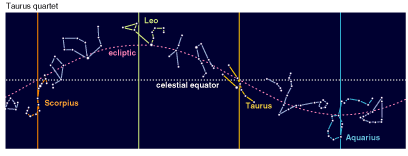
TAURUS: The Bull -- An important figure in Ancient Asian temples; a symbol of (Male) Virility/Fertility and Strength
LEO:The Lion -- another important worship figure; sign of power, in this case of the Sun at the height of the summer.
SCORPIO: The Scorpion -- reflects autumnal symbolism of the mighty Sun being stung (wounded) and falling from the sky
AQUARIUS: The Water Bearer -- a water-connected figure and the symbol of the Underworld
In another 1300 years, the constellations and the sun's position at
equinoxes would have been sufficiently out of sync that yet another quartet
of constellations, the last quartet, was put in place. This
last quartet, the Aries Quartet, was defined in approximately
1200 BC when the Sun would have been in the constellation of Aries on
March 21st.
The symbolism of the new quartet once again reflects the changing cultural
situation. Generally the constellations are not of Babylonian origin;
the Old Testament warnings against the cults of idols were on the rise;
monotheism was in ascendancy; art images and parables for their own sake
had become common in literature. The last quartet is supposed to reflect
all these developing elements.
 Aries Quartet
Aries Quartet
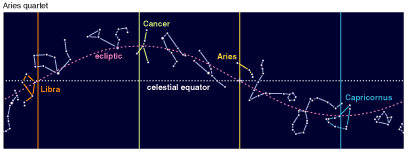
ARIES: The Ram or The Sacrificial Goat -- strongly connected to spring rituals throughout written history of the region and in religious texts, for example, Abraham's sacrificial ram.
CANCER The Crab -- sideways motion of the crab may be related to sun's apparent motion in the sky; the sun moving only sideways across the sky at summer solastice, not up or down.
LIBRA: The Scale or Balance -- possible reference to balance between day and night. The Akkadian name for the constellation that we call Libra translates to mean the horn of a scorpion, a possible reference to the scorpion's stinger. This latter designation fits in with the previous autumn constellations suggesting that the constellation's name must have been changed to Libra after the fact.
CAPRICORNUS The Goat-Fish -- a water-related creature of ancient Sumerian origin representing the underworld.
With the establishment of the final quartet, the zodiac constellations as
we know it were all in place. The present-day astrological associations with
the constellations are based on the location of the sun over the course
of the year as observed by Babylonian priests-cum-astronomers over 3000
years ago. The earth's axis continued to precess (wobble) and as in
the past, the constellations and the sun's location slowly moved out of sync.
Today, the sun is located somewhere between the constellations of Pisces and
Aquarius on March 21st. This also means that everything in the skies
happens about a month later than when the ancient observational calendars of
the Egyptian, Mesopotamian, Chinese, etc. were constructed, a fact that
that has be kept in mind by archeologists and historians.
Popular astrology that classifies a person born
on March 21st as Aries is now nearly 3000 years out of date!
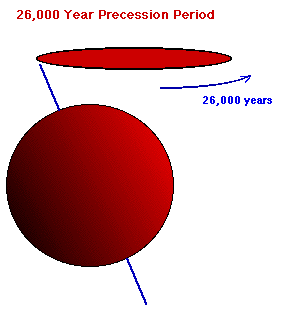
 In the above discussion of the zodical constellations, there is a mention
of the fact that the earth's rotation axis (north-south axis) is not fixed
in space but wobbles.
In other words, like a rotating toy top, the direction of the rotation axis
executes a slow precession, tracing out a circle in the sky. The precession
rate is approximately 1 degree every 72 years, resulting in approximately
26,000 years to complete the circle.
In the above discussion of the zodical constellations, there is a mention
of the fact that the earth's rotation axis (north-south axis) is not fixed
in space but wobbles.
In other words, like a rotating toy top, the direction of the rotation axis
executes a slow precession, tracing out a circle in the sky. The precession
rate is approximately 1 degree every 72 years, resulting in approximately
26,000 years to complete the circle.
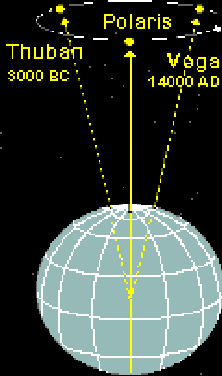 At present, this axis points roughly at a star called Polaris in the
constellation Little Dipper, the star often referred to as the North
Star. But Polaris wasn't and will not always be the pole star. In 3000
B.C., the star that always stood in one place was Thuban (Alpha Draconis).
In a little over 5000 years from now, Alpha Ceiphei will be the pole star,
then Deneb, then the bright star Vega in the constellation Lyra will be
approximately at the North Celestial Pole, then it'll swing around to
Thuban again and then, after 26,000 years, Polaris. For many centuries,
there has been and will be no bright star close to where the rotational
axis is pointing.
At present, this axis points roughly at a star called Polaris in the
constellation Little Dipper, the star often referred to as the North
Star. But Polaris wasn't and will not always be the pole star. In 3000
B.C., the star that always stood in one place was Thuban (Alpha Draconis).
In a little over 5000 years from now, Alpha Ceiphei will be the pole star,
then Deneb, then the bright star Vega in the constellation Lyra will be
approximately at the North Celestial Pole, then it'll swing around to
Thuban again and then, after 26,000 years, Polaris. For many centuries,
there has been and will be no bright star close to where the rotational
axis is pointing.
Since 1300 B.C., the epoch when the last quartet of Zodiac constellations
were put in place according Gurshtein, the direction of the earth's axis
has moved by a little over 44 degrees. Now, the sun completes the entire
circle (passing through all 12 constellations) year, therefore each
constellation occupies roughly 30 degrees of sky. Consequently, 44 degrees
shift due to precession means that the last Babylonian calendar of
celestial events would be off by one and a half months (and the usual
dates associated the astrological signs in newspapers is off by the same
amount).

|

|